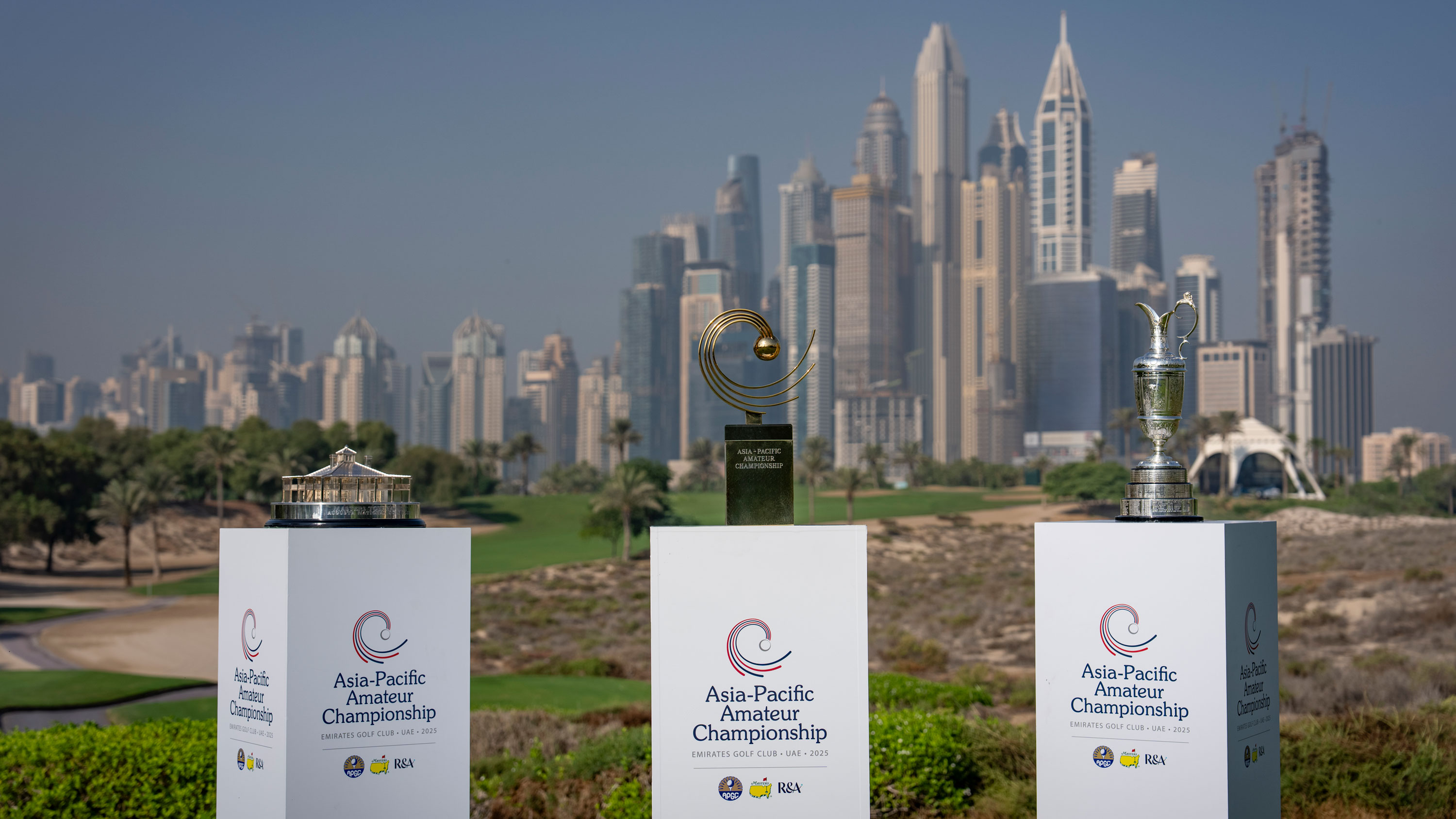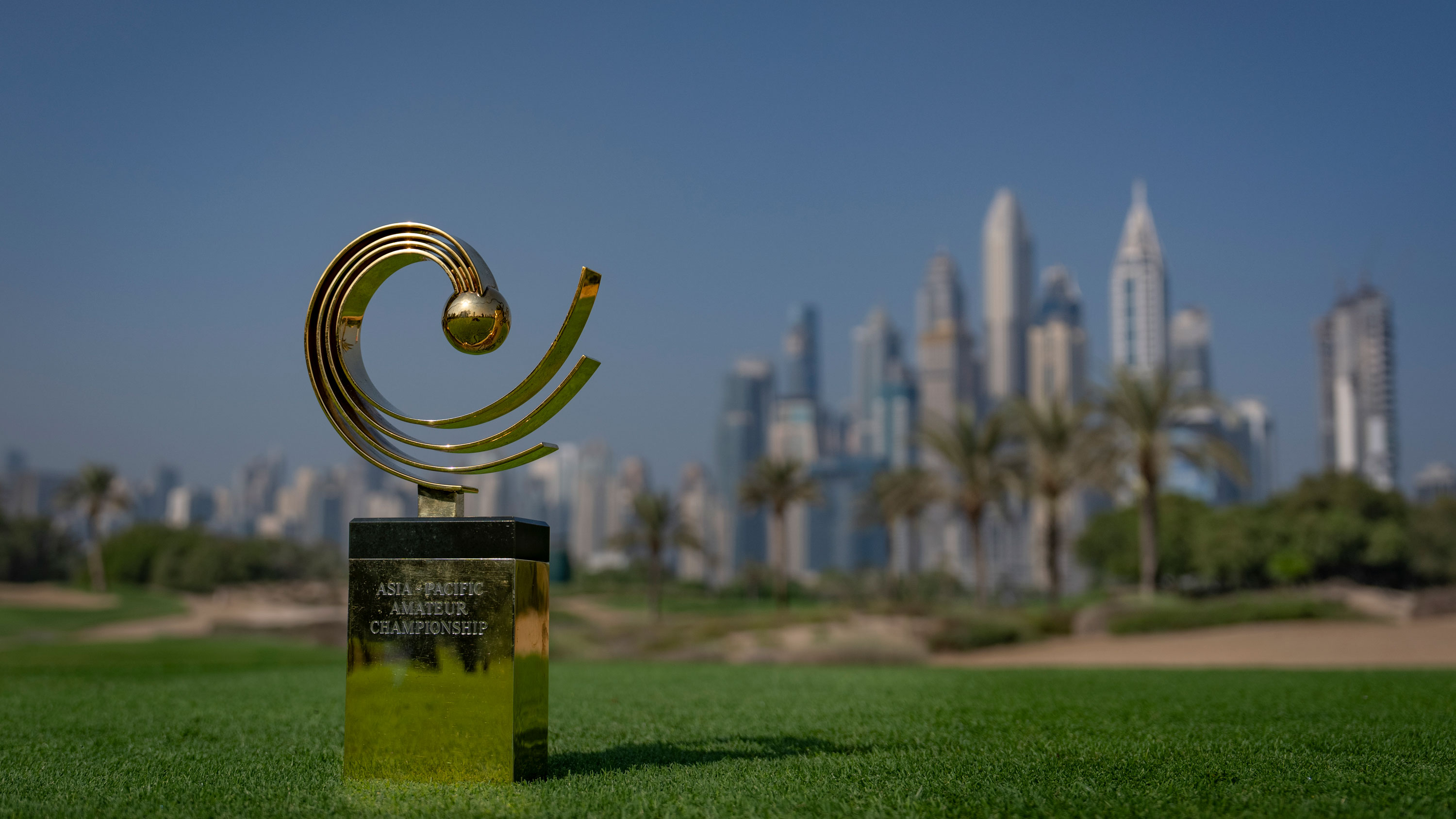Why The Asia Pacific Amateur Championship Has Been A Game-Changer For Golf
The AAC has inspired players to excel and others to set out on their golfing journeys. It has provided a template for growing the game.


The Asia Pacific Amateur Championship (AAC) was established in 2009 by The R&A, The Masters Tournament and the Asia Pacific Golf Federation.
Their aim was to develop elite golf in the Asia Pacific region and, in so doing, encourage wider male and female participation in the sport, right down to the grass roots level.
With the 16th edition of the tournament about to get underway. It would be fair to say, the mission of the governing bodies has been a successful one.
The AAC, the 16th instalment of which is being staged this week at The Emirates Golf Club in Dubai, has stimulated significant golfing growth in the Asia Pacific region over the last 15 years.

The AAC Trophy
Participation numbers are up, and a new generation of players has been inspired to take up the sport, with youngsters aiming to follow in the footsteps of past champions like 2021 Masters winner Hideki Matsuyama and past AAC competitor Cam Smith who won the 150th Open championship at St Andrews in 2022.
In addition to those direct positives, the AAC has also provided a blueprint for further elite amateur tournaments across the world.
Following the success of the AAC, The R&A and The Masters Tournament founded The Latin America Amateur Championship (LAAC) in 2014. It has produced great champions like Joaquin Niemann (who won in 2018.) Additionally, several former participants have gone on to enjoy professional success. They include Nico Echavarria and Sebastian Munoz, both of whom have won on the PGA Tour.
Subscribe to the Golf Monthly newsletter to stay up to date with all the latest tour news, equipment news, reviews, head-to-heads and buyer’s guides from our team of experienced experts.
The LAAC has propelled golf forwards in the Americas in the same way the AAC has done in Asia Pacific.
In 2018, The Women’s Asia Pacific Amateur Championship was founded, and it was followed in 2021 by the Women’s Latin America.
Completing the global set of elite amateur tournaments, 2024 saw the establishment of the African Amateur Championship and women’s equivalent.
The R&A is involved in all of these events which have been instrumental in developing golf in new regions from beginner level right up to the elite.
120 players will take part in the AAC this week in Dubai with 41 different countries and territories represented.
The winner of the AAC earns a place in both The Open Championship at Royal Birkdale and the 2026 Masters Tournament, plus an exemption for The Amateur Championship, the runner up or runners up gain a place in The Open Qualifying Series and the top-three will receive an exemption into The Amateur Championship.

One of the Australian team tees off towards Dubai
These are potentially life-changing prizes for the players who secure them, but the wider impact of the opportunities is the key thing for growing the game across Asia and the Pacific region.
National bodies have been encouraged to invest, not only in elite programmes but also in junior development and overall participation.
With the chance of creating new champions, golf benefits across the board as federations look to be more progressive and innovative with their investments for the future.
The R&A’s most recent global participation report, published earlier this year, shows a 5% increase in registered golfers in Asia between 2023 and 2024. The total number of golfers in Asia is now over 20 million, that’s up by nearly 7 million since 2012.
The number of golfers in Oceania has also increased significantly over that period.
Golf is growing in those regions and the AAC has undoubtedly been one of the catalysts for that growth.
I’m fortunate that this is the fifth time I have been able to travel to an AAC, firstly in 2010 when I watched Hideki Matsuyama win on home soil at Kasumigaseki Golf Club.
Things have changed quite a bit in 15 years, although the event was always run like a well-oiled machine… What else would you expect from The R&A and The Masters tournament?
But the AAC has grown significantly in stature with more countries producing more players who could mount a challenge. The players take this event very seriously, although there remains a great camaraderie between the competitors.
Elsewhere, there are more representatives of the media covering the event each year and the crowds get bigger. There’s increased interest from the wider golfing public as they recognise the possibility that future champions could be born at this tournament.
It's quite possibly the best-run tournament in world golf actually. The organisers have honed it to perfection over 15 previous runnings. It’s like a small but perfectly formed major.
The participants are certainly made to feel like they are playing in a major and it provides all those who take part with a golfing experience they will never forget.
The more established golfing nations are well represented this week. The likes of Australia, Japan, China and Thailand have strong teams.
But an indication of the AAC’s reach and impact is that countries you would never expect to participate in elite level golf have entrants. Bhutan, Laos, Papua New Guinea and Afghanistan (a chap called Iqbal Wali who I just watched hit an excellent drive off the 17th towards the end of his practice round) all those lesser-known golfing countries have golfers on the tee sheet this week.
The youngest player on the start list is 13-year-old Salem Alabdallat of Jordan while the oldest is Rachid Akl of Lebanon, who is 67. That gives an idea of the breadth of the appeal of this competition. Although most of the field is made up of aspiring youngsters, there are a few veterans in there too looking to cause an upset.
Another factor highlighting the significance of this event is the quality of the venues. I mentioned Kasumigaseki earlier – the venue for the Tokyo Olympics, but the event has also been contested at the magnificent Royal Melbourne and the highly regarded Sentosa in Singapore. These are world-class venues for a world-class tournament.
The objectives for the AAC at the outset were to increase participation and drive the elite game across the Asia Pacific region, not just in established golfing countries but also in nations with less, or no golfing pedigree.
Since its establishment, the tournament has succeeded in those objectives in Asia Pacific. But, more than that, it has played a key role in pushing golf in other regions of the world as the governing bodies have sought to replicate its success.
The AAC has created major champions, it has inspired youngsters, it has inspired investment from national federations across Asia Pacific and beyond… That is why it has been a game-changer for golf.

Fergus is Golf Monthly's resident expert on the history of the game and has written extensively on that subject. He has also worked with Golf Monthly to produce a podcast series. Called 18 Majors: The Golf History Show it offers new and in-depth perspectives on some of the most important moments in golf's long history. You can find all the details about it here.
He is a golf obsessive and 1-handicapper. Growing up in the North East of Scotland, golf runs through his veins and his passion for the sport was bolstered during his time at St Andrews university studying history. He went on to earn a post graduate diploma from the London School of Journalism. Fergus has worked for Golf Monthly since 2004 and has written two books on the game; "Great Golf Debates" together with Jezz Ellwood of Golf Monthly and the history section of "The Ultimate Golf Book" together with Neil Tappin , also of Golf Monthly.
Fergus once shanked a ball from just over Granny Clark's Wynd on the 18th of the Old Course that struck the St Andrews Golf Club and rebounded into the Valley of Sin, from where he saved par. Who says there's no golfing god?
You must confirm your public display name before commenting
Please logout and then login again, you will then be prompted to enter your display name.